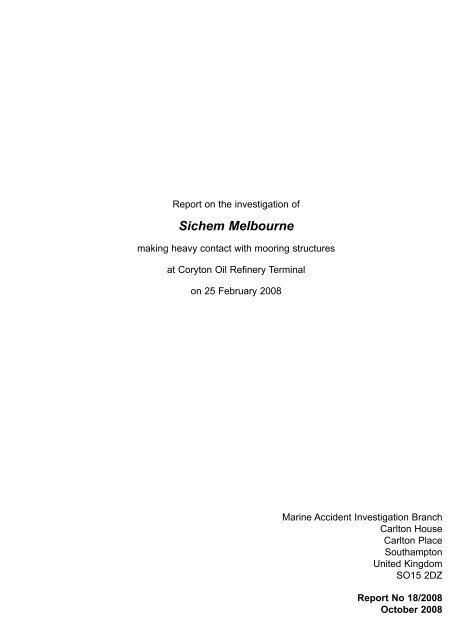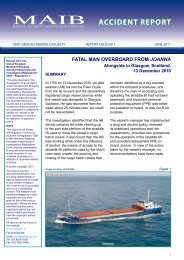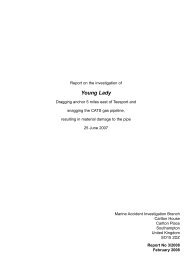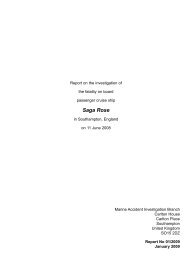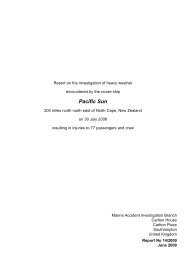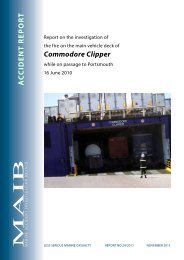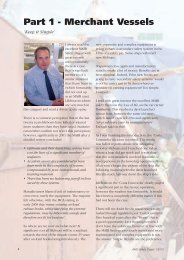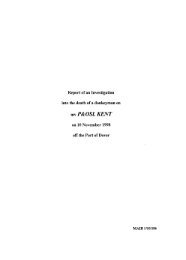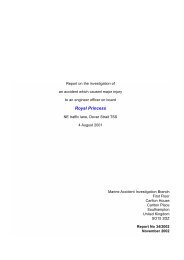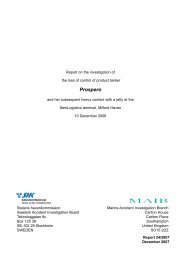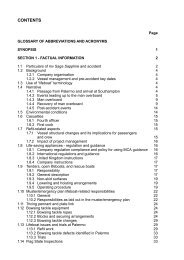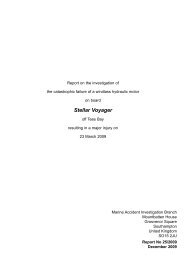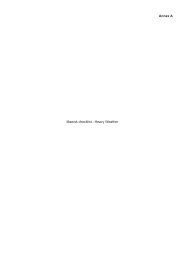Sichem Melbourne - Marine Accident Investigation Branch
Sichem Melbourne - Marine Accident Investigation Branch
Sichem Melbourne - Marine Accident Investigation Branch
You also want an ePaper? Increase the reach of your titles
YUMPU automatically turns print PDFs into web optimized ePapers that Google loves.
Report on the investigation of<br />
<strong>Sichem</strong> <strong>Melbourne</strong><br />
making heavy contact with mooring structures<br />
at Coryton Oil Refinery Terminal<br />
on 25 February 2008<br />
<strong>Marine</strong> <strong>Accident</strong> <strong>Investigation</strong> <strong>Branch</strong><br />
Carlton House<br />
Carlton Place<br />
Southampton<br />
United Kingdom<br />
SO15 2DZ<br />
Report No 18/2008<br />
October 2008
Extract from<br />
The United Kingdom Merchant Shipping<br />
(<strong>Accident</strong> Reporting and <strong>Investigation</strong>)<br />
Regulations 2005 – Regulation 5:<br />
“The sole objective of the investigation of an accident under the Merchant Shipping (<strong>Accident</strong><br />
Reporting and <strong>Investigation</strong>) Regulations 2005 shall be the prevention of future accidents<br />
through the ascertainment of its causes and circumstances. It shall not be the purpose of an<br />
investigation to determine liability nor, except so far as is necessary to achieve its objective, to<br />
apportion blame.”<br />
NOTE<br />
This report is not written with litigation in mind and, pursuant to Regulation 13(9) of the<br />
Merchant Shipping (<strong>Accident</strong> Reporting and <strong>Investigation</strong>) Regulations 2005, shall be<br />
inadmissible in any judicial proceedings whose purpose, or one of whose purposes is to<br />
attribute or apportion liability or blame.<br />
Further printed copies can be obtained via our postal address, or alternatively by:<br />
Email: maib@dft.gsi.gov.uk<br />
Tel: 023 8039 5500<br />
Fax: 023 8023 2459<br />
All reports can also be found on our website:<br />
www.maib.gov.uk
CONTENTS Page<br />
GLOSSARY OF ABBREVIATIONS AND ACRONYMS<br />
SYNOPSIS 1<br />
SECTION 1 - FACTUAL INFORMATION 2<br />
1.1 Particulars of <strong>Sichem</strong> <strong>Melbourne</strong> and accident 2<br />
1.2 Narrative 3<br />
1.2.1 Environmental conditions 3<br />
1.2.2 Events leading to the accident 3<br />
1.2.3 Post-accident 6<br />
1.3 <strong>Sichem</strong> <strong>Melbourne</strong> 11<br />
1.4 Vessel management 11<br />
1.5 Master 11<br />
1.6 Bridge manning 12<br />
1.7 Port of London Authority 12<br />
1.7.1 Pilotage 14<br />
1.7.2 Pilot training 16<br />
1.7.3 Pilot 16<br />
1.8 Petroplus 16<br />
SECTION 2 - ANALYSIS 19<br />
2.1 Aim 19<br />
2.2 Cause of the accident 19<br />
2.3 Pilotage 19<br />
2.4 Master / pilot exchange of information 20<br />
2.5 Communications 20<br />
2.6 Thruster control positioning 21<br />
2.7 Engine failure 21<br />
2.8 Petroplus 22<br />
2.9 Use of tugs 22<br />
2.10 Tide 22<br />
2.11 Fatigue 22<br />
2.12 Similar accidents 22<br />
SECTION 3 - CONCLUSIONS 24<br />
3.1 Safety issues 24<br />
3.2 Safety issues directly contributing to the accident which have<br />
resulted in recommendations 24<br />
3.3 Safety issues identified during the investigation which have<br />
not resulted in recommendations but have been addressed 24<br />
SECTION 4 - ACTION TAKEN 25<br />
4.1 Actions taken by EMS ship management (India) PVT. Ltd. 25<br />
4.2 Actions taken by Petroplus 25<br />
4.3 Actions taken by Port of London Authority 25<br />
4.4 MAIB 25<br />
SECTION 5 - RECOMMENDATIONS 26
GLOSSARY OF ABBREVIATIONS AND ACRONYMS<br />
AB - Able Bodied Seaman<br />
AIS - Automatic Identification System<br />
BPM - Bridge Procedures Manual<br />
BTM - Bridge Team Management<br />
Cable - 0.1 nautical mile<br />
CDI - Chemical Distribution Institute<br />
CHA - Competent Harbour Authority<br />
DfT - Department for Transport<br />
DNV - Det Norske Veritas<br />
EMS - Eitzen Maritime Services<br />
Head down - Facing downstream towards the sea<br />
ICS - International Chamber of Shipping<br />
IMO - International Maritime Organization<br />
ISM - International Management Code for the Safe Operation of Ship<br />
and for Pollution Prevention<br />
kts - knots<br />
kW - kilowatt<br />
LNG - Liquefied Natural Gas<br />
LPG - Liquefied Petroleum Gas<br />
m - metre<br />
No - Number<br />
OCIMF - Oil Companies International <strong>Marine</strong> Forum<br />
PLA - Port of London Authority<br />
PLVTS - Port of London Vessel Traffic Services<br />
PMSC - Port <strong>Marine</strong> Safety Code<br />
POAP - Pilots’ Operational Advisory Panel
SIRE - Ship Inspection Report<br />
SMS - Safety Management System<br />
S-VDR - Simplified Voyage Data Recorder<br />
UK - United Kingdom<br />
USCG - United States Coast Guard<br />
UTC - Universal Co-ordinated Time<br />
VDR - Voyage Data Recorder<br />
VHF - Very High Frequency<br />
VTS - Vessel Traffic Services<br />
All times used in this report are UTC unless otherwise stated
Figure 1<br />
<strong>Sichem</strong> <strong>Melbourne</strong>
SYNOPSIS<br />
On the evening of 25 February 2008 the product carrier, <strong>Sichem</strong><br />
<strong>Melbourne</strong>, sustained damage and damaged mooring structures as<br />
she departed her berth at Coryton Oil Refinery on the River Thames<br />
estuary. Fortunately, her broadside contact with a mooring dolphin<br />
prevented <strong>Sichem</strong> <strong>Melbourne</strong> from striking an oil tanker which was<br />
discharging on a neighbouring jetty.<br />
At departure, <strong>Sichem</strong> <strong>Melbourne</strong> was laying port side to Coryton<br />
Number 3 jetty, heading downstream, stern towards the last of the<br />
ebb tide, with a light wind onto the ship’s starboard quarter. A Port of London Authority (PLA)<br />
pilot boarded to conduct the navigation of the vessel during the departure. Following a brief<br />
exchange between the vessel’s master and the pilot, the vessel’s moorings were singled<br />
up. The pilot made a comment to the master that an hour of ebb tide remained and that,<br />
consequently, they should use the bow spring in letting go. The pilot did not fully explain how<br />
he intended to move the vessel clear of the jetty.<br />
The pilot, who was stationed on the port bridge wing with the master, gave instructions to<br />
come ahead on the forward springs with hard port rudder, with the intention of creating a<br />
“wedge” of water between the ship and jetty, before coming astern into the river and current.<br />
When an angle of about 7º had developed between the ship’s stern and the jetty, the master<br />
applied bow thrust to starboard to prevent her bow leaning against the jetty. Soon after this<br />
the bow spring was cast off before the pilot was ready, allowing the ship to move forward<br />
before the current. Combined effects of increased starboard bow thrust and wind on the<br />
starboard quarter caused the ship’s port quarter to fall back and scour the jetty before she<br />
cleared the structure. Once clear of the jetty the pilot attempted to retrieve his original plan<br />
of getting the stern outwards by applying port wheel and more ahead power. The master,<br />
however, was under the impression that the pilot was trying to lift the vessel bodily into the<br />
river, and applied more starboard thrust to assist. The following tidal stream prevented<br />
transverse lifting of the ship and she was carried down onto other mooring structures.<br />
During attempts to recover the situation, numerous, rapid, ahead/astern movements were<br />
placed on the main engine, resulting in the engine’s safety management system shutting down<br />
the main engine. Fortunately, the engine was quickly restarted, allowing the vessel to clear a<br />
tanker which was berthed on an adjoining jetty.<br />
<strong>Sichem</strong> <strong>Melbourne</strong> was diverted to Southend anchorage where she was inspected for damage<br />
by a classification society surveyor, before being allowed to sail.<br />
The MAIB investigation identified contributing factors to the accident:<br />
• There was an inadequate exchange of information between master and pilot before<br />
commencing unmooring operations.<br />
•<br />
•<br />
Interaction and communications between members of the bridge team were poor.<br />
Much of the conversation between the crew was conducted in the Russian language.<br />
This effectively excluded the pilot from the bridge team.<br />
Recommendations have been made to all UK Competent Harbour Authorities, and EMS<br />
Ship Management (India) Pvt. Ltd, with the aim of improving: port procedures; pilot/master<br />
interaction; bridge team management and pilot monitoring. A recommendation has also been<br />
made to the terminal operator regarding its marine risk assessment.<br />
1
SECTION 1<br />
2<br />
- FACTUAL INFORMATION<br />
1.1 PARTICULARS OF SicheM <strong>Melbourne</strong> (FIGURE 1) AND ACCIDENT<br />
Vessel details<br />
Registered owner : Eitzen Chemical Singapore Pte<br />
Manager(s) : Eitzen Maritime Services, Ship Management<br />
(India) Pvt. Ltd<br />
Port of registry : Singapore<br />
Flag : Singapore<br />
Type : Type 2 Chemical/Product carrier<br />
Built : 2007, South Korea<br />
Classification society : Det Norske Veritas<br />
Construction : Welded steel, double hull<br />
Length overall : 127.2m<br />
Gross tonnage : 8,455<br />
Engine power and/or type : 4440kW. STX-B&W 6S35MC<br />
Service speed : 12.4kts<br />
Other relevant info : Fixed pitch, right handed propeller;<br />
402kW bow thruster; semi balanced rudder<br />
<strong>Accident</strong> details<br />
Time and date : 25 February 2008, 2015<br />
Location of incident : Coryton Oil Refinery, River Thames<br />
Persons on board : 19<br />
Injuries/fatalities : None<br />
Damage : Damage to vessel shell plating, frames and rails;<br />
damage to jetty and mooring dolphins.
1.2<br />
1.2.1<br />
1.2.2<br />
NARRATIVE<br />
Much of the information in this report is derived from analysis of data retrieved from<br />
<strong>Sichem</strong> <strong>Melbourne</strong>’s Simplified Voyage Data Recorder (S-VDR).<br />
Environmental conditions<br />
• Dark<br />
•<br />
•<br />
•<br />
•<br />
•<br />
Wind: SW, Beaufort force 4<br />
Sea state, smooth<br />
Good visibility<br />
Spring tide +2 days; 1 hour before low water<br />
Approximately ½ to 1 knot easterly setting tidal stream, parallel to jetty 3.<br />
Events leading to the accident<br />
<strong>Sichem</strong> <strong>Melbourne</strong> completed the discharge of a cargo of gas oil at Coryton refinery<br />
during the evening of 25 February 2008. Arrangements were then made for the vessel<br />
to sail from the terminal’s No 3 berth, where she was lying port side to and heading<br />
downstream, for the NE Spit anchorage at the entrance to the River Thames.<br />
A PLA pilot boarded the ship at 1951 and proceeded to the bridge, where he met the<br />
master some 6 minutes later. During the initial discussions between the pilot and the<br />
master it was revealed that the latter thought that <strong>Sichem</strong> <strong>Melbourne</strong> was to proceed to<br />
the Sunk anchorage rather than the NE Spit anchorage. The discrepancy was clarified<br />
and it was agreed that the vessel would proceed to the NE Spit anchorage.<br />
A master and pilot exchange of information was carried out; this included pilot card<br />
items, draft confirmation, and questioning whether the vessel was similar to her sister<br />
ship, <strong>Sichem</strong> Edinburgh, which the pilot was familiar with. Both pilot and master had<br />
prepared passage plans covering the departure operation, however at no time were<br />
these compared or discussed. The pilot advised the master that, as an ebb tide was<br />
running, care would be needed when releasing the stern lines (just in case they were<br />
carried into the propeller by the tidal stream). The master asked which would be the<br />
last line to let go; the pilot advised it would be the forward spring.<br />
The chief officer explained to the pilot that the vessel’s automatic identification system<br />
(AIS) had suffered antennae damage on her inward voyage, and that a new one was<br />
now fitted, but that he was not sure if it was working properly. All pre-departure checks<br />
of engines and equipment were carried out, and the master informed the pilot that all<br />
was well and, specifically, that the bow thruster was working.<br />
As the vessel was facing downstream, port side to, the pilot’s intention was to come<br />
ahead on the forward springs and allow a substantial wedge of water to form between<br />
the ship’s stern and the jetty, putting the south westerly wind dead astern or fine on the<br />
port quarter. At this point he planned to let go the springs and bring the vessel astern<br />
into the channel. The plan to bring the vessel astern, however, was not discussed<br />
or shared with the master because the pilot felt it was self-explanatory. The master<br />
believed that, as there was only an hour of ebb tide to run, the stream would be fairly<br />
slack and that they would sail out ahead, away from the berth, on a course of 139˚, as<br />
3
4<br />
indicated on his passage plan (Annex 1). Had the stream been stronger, he believed<br />
that tug assistance would have been required. Again, this was not discussed with the<br />
pilot.<br />
During the departure operation, the master and pilot were both stationed on the port<br />
bridge wing. After receiving clearance to sail from the Port of London Vessel Traffic<br />
Services (PLVTS), the mooring ropes were singled up and then cast off; leaving only the<br />
forward springs attached. At 2018, the pilot ordered the wheel to be placed hard to port<br />
and the engines on dead slow ahead. Some 30 seconds later the master engaged the<br />
bow thruster with 50% power to starboard, thus preventing the ship’s bow from pressing<br />
against the jetty. The master was positioned so that his body shielded the thruster<br />
controls from the pilot’s vision; however this first thruster manoeuvre was done with the<br />
knowledge of the pilot, who was not particularly in favour of it, but passed no comment.<br />
Two minutes later, with an angle of less than 7º between the ship and jetty, the pilot<br />
requested the engine to be stopped due both to the strain on the remaining ropes and<br />
to evaluate the ship’s positioning. The angle between the ship and jetty increased<br />
slightly and it was the master’s understanding that the pilot was now ready to let go, and<br />
therefore ordered, in Russian, the forward springs to be cast off and simultaneously gave<br />
full bow thrust to starboard. Because the order was given in Russian, the pilot was not<br />
aware the remaining ropes to the jetty were being released until they had been let go.<br />
But he still made no comment to the master. The wind was still on the starboard quarter<br />
at this time and this, combined with the effect of the increased bow thruster caused the<br />
ship’s port quarter to move towards the jetty as the vessel gathered way. The pilot was<br />
concerned at the early release of the ropes but felt that he could retrieve the situation by<br />
moving the ship’s head to port and then coming astern into the channel. However, this<br />
intention was not communicated to the master, who continued to operate the vessel’s<br />
bow thruster on full power to starboard in an attempt to avoid contact of the bow with the<br />
forward mooring dolphin. Consequently, <strong>Sichem</strong> <strong>Melbourne</strong>’s port quarter scraped the<br />
face of the jetty as the ship moved ahead.<br />
The pilot made an attempt to stop the ship’s forward movement by giving instructions to<br />
come astern, however this resulted in transverse thrust from the right handed propeller<br />
setting the ship towards the shore and mooring dolphin MD35 (Figure 2). On seeing<br />
this, the pilot requested that the engines were put half ahead, and the helm hard aport<br />
in a further attempt to pivot <strong>Sichem</strong> <strong>Melbourne</strong> clear of the dolphin and move her stern<br />
towards the channel; this was thwarted by the master once more applying starboard<br />
bow thrust without the pilot’s knowledge. Consequently the ship made contact with the<br />
dolphin MD35.<br />
Jetty 3’s supervisor observed <strong>Sichem</strong> <strong>Melbourne</strong>’s departure and erratic manoeuvres,<br />
and called, using VHF radio, firstly the ship and then the harbourmaster’s launch, to<br />
advise that <strong>Sichem</strong> <strong>Melbourne</strong> had hit the dolphin. He also warned that there was<br />
a danger that she may experience further problems, and requested tug assistance.<br />
Unfortunately this transmission was lost due to both parties speaking on the radio<br />
simultaneously. The transmission did, however, alert berthing and workboat staff on jetty<br />
1 (Figure 2), who then observed the wayward ship and evacuated the structure as she<br />
bore down on them.
Reproduced from Admiralty Chart BA 1186 by permission of<br />
the Controller of HMSO and the UK Hydrographic Office.<br />
Jetty no.1<br />
Jetty no.3<br />
Jetty no.4<br />
MD41<br />
MD35<br />
Thornbury<br />
Track of <strong>Sichem</strong> <strong>Melbourne</strong><br />
Figure 2<br />
Modified chart showing berths at Coryton Refinery<br />
5
1.2.3<br />
6<br />
The pilot decided to regain control of the situation by laying <strong>Sichem</strong> <strong>Melbourne</strong><br />
alongside the empty jetty 1 (which frequently berths liquefied petroleum gas (LPG)<br />
carriers) and then get tugs to pull her clear, but he did not communicate this plan to<br />
the master. The master, on seeing <strong>Sichem</strong> <strong>Melbourne</strong> moving towards jetty 1, took<br />
command and forcefully steered the vessel clear of jetty 1 with the use of engine,<br />
rudder and thruster manoeuvres. However, this placed the vessel in danger of being<br />
carried broadside towards the causeway and pipe line carrying oil from the tanker<br />
Thornbury, discharging on jetty 4 (Figure 2). A rapid series of full ahead / full astern<br />
manoeuvres then took place, with the master and pilot countermanding each other’s<br />
orders at one point until, at 2029.40, the main engine’s safety management system cut<br />
in and shut the engine down. The ship still had some 3.5kts of way on her at this point<br />
and she landed heavily on the mooring dolphin MD41 (Figure 2), which held the stern<br />
lines for Thornbury, displacing the supporting legs of the dolphin. On notification of the<br />
engine failure, the pilot immediately requested tug assistance via PLVTS, and the duty<br />
tug, Castlepoint, was dispatched from her station nearby.<br />
The chief engineer succeeded in quickly resetting the engine and regaining power,<br />
allowing <strong>Sichem</strong> <strong>Melbourne</strong> to clear Thornbury’s stern by a very small margin and pass<br />
into the main channel.<br />
Post-accident<br />
The pilot notified PLVTS that engine power in <strong>Sichem</strong> <strong>Melbourne</strong> had been restored<br />
and the vessel was proceeding downstream. He then contacted the duty port controller<br />
and told him of the incident and cancelled his previous request for tug assistance. The<br />
duty port controller advised the pilot to take the ship to nearby Southend anchorage<br />
until it could be established what damage had been done to the vessel and the jetty<br />
structures.<br />
As the mooring structure holding Thornbury’s stern line had been damaged, discharge<br />
was suspended and the tug Stanford was dispatched to push against her stern as a<br />
precautionary measure, until the dolphin could be properly inspected for damage.<br />
With <strong>Sichem</strong> <strong>Melbourne</strong> proceeding towards the anchorage, the ship’s damage control<br />
party established that she had not sustained serious damage and the master notified<br />
his managers, EMS Ship Management, India, of the accident. <strong>Sichem</strong> <strong>Melbourne</strong><br />
anchored safely at Southend without further incident.<br />
At daylight the next morning the full extent of the damage to both ship (Figures 3a,<br />
b, c, d) and mooring structures (Figures 4a, b, c, d) was established. The mooring<br />
dolphins were inspected by divers for foundation damage, and were deemed secure.<br />
Temporary repairs were carried out above water and the dolphins were declared sound<br />
enough to attach ropes to, and safe for personnel.<br />
Following an inspection of <strong>Sichem</strong> <strong>Melbourne</strong>’s main engine controls and hull damage<br />
by a surveyor from the ship’s classification society, Det Norske Veritas (DNV), the<br />
ship was allowed to sail, in ballast, to a repair yard. Her full term Safety Construction<br />
Certificate was withdrawn and a short term certificate, valid for 6 days, was issued in<br />
its place. No deficiencies were found with the engine control system and the ship’s<br />
manager made arrangements for hull repairs to be carried out.
Damage to <strong>Sichem</strong> <strong>Melbourne</strong>’s sheer strake and deck edge<br />
Deck edge damage<br />
Figure 3a<br />
Figure 3b<br />
7
8<br />
Rail damage<br />
Hole in deck<br />
Figure 3d<br />
Figure 3c
Damage to MD 41 mooring structure and stern lines leading to Thornbury<br />
Damage to MD 41 mooring structure and stern lines leading to Thornbury<br />
Figure 4a<br />
Figure 4b<br />
9
10<br />
Damage to MD 41 mooring structure<br />
Damage to MD 41 mooring structure<br />
Figure 4c<br />
Figure 4d
1.3 SicheM <strong>Melbourne</strong><br />
1.4<br />
1.5<br />
<strong>Sichem</strong> <strong>Melbourne</strong> was delivered by her builders in late July 2007. She was owned<br />
by Eitzen Chemical (Singapore) Pte Ltd and managed by EMS Ship Management<br />
(India) Pvt. Ltd. The vessel was on spot charter to Trafigura Beheer BV at the time of<br />
the accident, having just delivered a cargo of gas oil from Brofjorden, Norway, to the<br />
Petroplus refinery. Following her departure from Coryton, she was to await orders for<br />
her onward destination.<br />
In the previous months, <strong>Sichem</strong> <strong>Melbourne</strong> had been chartered to various major oil<br />
companies including Shell, Statoil Hydro and BP, trading regularly between Europe<br />
and Canada. These companies all belong to the Oil Companies International <strong>Marine</strong><br />
Forum (OCIMF) and had carried out stringent validation of <strong>Sichem</strong> <strong>Melbourne</strong> through<br />
OCIMF’s Ship Inspection Report Programme (SIRE) for the carriage of petrochemicals.<br />
At the time of the accident <strong>Sichem</strong> <strong>Melbourne</strong> held approval from: Shell; BP; Statoil<br />
Hydro; and Repsol for the carriage of their cargoes. Additionally, she held approvals<br />
from Chemical Distribution Institute (CDI) and the United States Coast Guard (USCG).<br />
<strong>Sichem</strong> <strong>Melbourne</strong> had a safe manning certificate for 12, but carried a crew of 18. This<br />
increased crewing allowed officers to work a routine of 4 hours “on duty” followed by<br />
8 hours “off.” The official language on board all EMS ships was English; the working<br />
language on <strong>Sichem</strong> <strong>Melbourne</strong>, however, was Russian, as the crew were a mix of<br />
Ukrainian, Russian and Latvian nationalities.<br />
The vessel was equipped with a JRC S-VDR. This recorded much of the vessel’s<br />
activities including: helm, engine, bow thrust and speech data.<br />
<strong>Sichem</strong> <strong>Melbourne</strong> was fitted with a single-acting reversible crosshead main engine.<br />
At full sea speed, the time required to reverse the engine from full ahead to full astern<br />
was approximately 326 seconds. The engine had a standard management system<br />
designed to protect it from excessive rapid ahead and astern demands. During the<br />
accident, the management system functioned appropriately and shut the engine down.<br />
VESSEL MANAGEMENT<br />
The managers of <strong>Sichem</strong> <strong>Melbourne</strong> provided a full management service, including<br />
crewing and technical operation, for 22 ships belonging to Eitzen Chemicals<br />
(Singapore) Pte. Ltd. The managers held a valid ISM Code Document of Compliance<br />
issued by Det Norske Veritas on behalf of the Republic of Singapore, for the operation<br />
of bulk carriers, oil tankers and chemical tankers.<br />
An audit by DNV 12 weeks before the accident confirmed that <strong>Sichem</strong> <strong>Melbourne</strong>’s<br />
SMS complied with the ISM Code, and a Safety Management Certificate valid for<br />
5 years had been issued. The SMS incorporated a ship operations manual, which<br />
detailed the company’s requirement for port departure procedures (Annex 2).<br />
MASTER<br />
The master’s career spanned 21 years at sea, qualifying as deep sea master in 2001 at<br />
Kiev, Ukraine. He had worked for EMS (through various management name changes)<br />
for 10 years; 5 years of that as chief officer and 5 years as master on chemical tankers.<br />
He held a Singaporean endorsement to his masters’ certificate. As part of his training,<br />
the master had attended Bridge Team and Resource Management training in 2001 and<br />
Ship Handling by bridge simulator in 2006.<br />
11
1.6<br />
1.7<br />
12<br />
The master was half way through a 4-month contract on board <strong>Sichem</strong> <strong>Melbourne</strong>, and<br />
had previous experience on the sister ships <strong>Sichem</strong> Rio and <strong>Sichem</strong> New York. He<br />
had visited Coryton about 20 times before as chief officer on various vessels. On the<br />
majority of those occasions, the vessel had sailed from her berth head to tide. This was<br />
the master’s first time at Coryton as master of a vessel.<br />
BRIDGE MANNING<br />
At the time of the accident, the bridge was manned by the master, pilot, chief officer and<br />
a helmsman. The chief officer and helmsman were positioned by the bridge telegraph<br />
and helm respectively, while the pilot and master were stationed on the bridge wing with<br />
the master in position to control the bow thrusters (Figures 5a, b). The bow thruster<br />
control was placed in a convenient position for operation on the bridge wing, but the<br />
pilot’s view of this was obscured by the master’s body.<br />
Communications to the bridge control stations and mooring parties were given by<br />
radio from the master, with the relevant instructions repeated by the chief officer and<br />
helmsman before applying them.<br />
PORT OF LONDON AUThORITY<br />
As a self-funding public trust, PLA is the competent authority with statutory responsibility<br />
for conservancy and navigational regulation on 94 miles of the tidal River Thames. As<br />
well as pilotage, the Authority provides navigational services for ships using the port,<br />
including the maintenance of shipping channels, moorings, lights and buoys.<br />
The PLA is a signatory to the Port <strong>Marine</strong> Safety Code (PMSC), a Department<br />
for Transport (DfT) code of practice for Competent Harbour Authorities (CHAs).<br />
Participation of the Code requires CHAs to maintain a navigational safety management<br />
system (SMS) based on formal risk assessment. The PLA risk assessment recognised<br />
the possibility of ships colliding with mooring structures within its waters, and pilotage,<br />
by trained experienced pilots, was one of its ultimate controls to reduce such<br />
happenings. An extract from the PLA risk assessment relating to mooring structure and<br />
moored ship contacts is at Annex 3.<br />
An integral part of the PLA SMS is its “Code of Practice for Ship Towage Operations on<br />
the Thames”; a voluntary code of good practice. Although tug assisted manoeuvring<br />
is voluntary, PLA does have the power to mandate tug assistance under its<br />
Harbourmaster’s Special Directions, which also incorporates pilots’ advice to masters to<br />
employ tug assistance, if deemed appropriate.<br />
PLA does not mandate tug assisted manoeuvring, however many of the berth owners<br />
and operators, including Petroplus, do. Where compulsory towage is required by berth<br />
owners/operators, the requirements are equivalent to, or in excess of, those proposed<br />
by the PLA towage Code of Practice.<br />
The PLA is a proactive member of all port operator safety committees and encourages<br />
operator involvement in issues of navigational safety. Authority representatives<br />
participate in Coryton terminal safety meetings, which convene every 2 months and are<br />
hosted by Petroplus.
Bridge wing and bow thruster control<br />
Detail of bow thruster control<br />
Figure 5b<br />
Figure 5a<br />
13
14<br />
The Authority also actively promotes a forum for its pilots, the Pilots’ Operational<br />
Advisory Panel (POAPs), where pilots’ representatives and management meet to<br />
discuss issues with a view to improving common goals. Additionally, a hazard review<br />
panel, comprising managers and pilots, meets on a two monthly basis where they<br />
frequently discuss issues taken forward by Navigation Advisory Panels, which may be<br />
formed following incidents on the river.<br />
PLA owns, in conjunction with HR Wallingford 1 , a sophisticated two dimensional tidal<br />
model, which gives detailed tidal predictions at various points on the River Thames; the<br />
predictions for Coryton at the time of the accident are shown in Figure 6. Observed<br />
tidal values and surge differences from the predicted datum are monitored at various<br />
points throughout the river; Figure 7 gives this information for Coryton, 2 hours before<br />
and after the incident. This indicates that the heights of tide, and therefore stream<br />
velocity at the time of the accident, to be very close to the predicted values.<br />
1.7.1 Pilotage<br />
The London Pilotage District stretches from Putney Bridge in the west to the Sunk pilot<br />
station in the east. At the time of the accident the PLA employed 90 pilots of varying<br />
proficiency and ability, including:<br />
• Twelve berthing pilots – specialist senior sea pilots retained for their experience<br />
of safely berthing and unberthing tankers of > 11,000GT or 160m in length.<br />
• Sixty six sea pilots, ranging from class 4 to class 1 pilots, responsible for<br />
navigating vessels safely from the outer pilot stations to inland as far as<br />
Crayfordness.<br />
• Twelve river pilots who specialise in the stretch of the river between Gravesend<br />
and London Bridge, three of whom are bridge pilots specialising in under bridge<br />
clearance from London Bridge to Putney Bridge.<br />
Compulsory pilotage is required for, among others: all specified vessels (vessels<br />
carrying explosives, flammables etc); vessels > 50m carrying marine pollutant in bulk,<br />
and vessels with an operating draught of 5m or more.<br />
PLA pilots work a 9 days “on”, 6 days “off” rota, with pilots moving to the bottom of the<br />
“turns list” after completing a “trip” or act of pilotage. This normally allowed no fewer<br />
than 8 hours off duty after an 8 hour “trip”, or 12 hours off after a 12 hour “trip” etc. The<br />
system allowed the Authority to service an average of 26 sea pilotage acts and 5 river<br />
acts daily.<br />
After being notified of a pending “trip,” pilots had the option of either attending the pilots’<br />
“ready room”, at PLA offices, to make preparations for their trip or, where a pilot had<br />
external internet access to POLARIS (the Port’s Ship Information System), they could<br />
join a ship directly from home. A fundamental part of a pilot’s preparation for a “trip”<br />
is the compiling of a Passage Plan. PLA had a house style Master/Pilot Information<br />
Exchange and Passage Plan (Annex 4), but did not insist on its use by their pilots;<br />
this plan had a section dedicated to manoeuvring and mooring. PLA allowed pilots to<br />
1 HR Wallingford: Independent research and consultancy experts in civil engineering and environmental<br />
hydraulics; formerly the Hydraulics Research Station of the UK Government.
1.00<br />
0.01<br />
0.18<br />
0.56<br />
1.13<br />
1.00<br />
1.00<br />
1.00<br />
0.15<br />
1.33<br />
0.18<br />
1.00<br />
1.00<br />
0.00<br />
Figures 6 and 7 courtesy of the<br />
Port of London Authority (PLA)<br />
1.00<br />
0.94<br />
1.15<br />
0.14<br />
1.00<br />
1.00<br />
1.00<br />
0.06<br />
0.42<br />
0.99<br />
1.15<br />
1.00<br />
0.02<br />
0.09<br />
0.73<br />
No.5<br />
Tide<br />
Gauge<br />
1.11<br />
1.21<br />
0.07<br />
0.22<br />
Spring Tide Flows hw Southend +5hrs<br />
Rate in Knots<br />
0.34<br />
1.02<br />
1.20<br />
CORYTON<br />
0.29<br />
1.00<br />
0.27<br />
0.88<br />
1.21<br />
1.24<br />
0.23<br />
0.01<br />
0.23<br />
0.72<br />
1.28 1.17<br />
1.27<br />
1.00<br />
1.16<br />
1.13<br />
1.11 1.15<br />
1.16<br />
1.17<br />
1.20<br />
0.16<br />
1.00<br />
0.54<br />
1.20<br />
1.28<br />
0.03<br />
Position Date and time Observed tide (m) Difference to prediction (m)<br />
CORYTON 25/02/2008 18:30 2.73 -0.02<br />
CORYTON 25/02/2008 18:40 2.53 0.00<br />
CORYTON 25/02/2008 18:50 2.34 0.01<br />
CORYTON 25/02/2008 19:00 2.16 0.02<br />
CORYTON 25/02/2008 19:10 1.98 0.02<br />
CORYTON 25/02/2008 19:20 1.81 0.01<br />
CORYTON 25/02/2008 19:30 1.66 0.01<br />
CORYTON 25/02/2008 19:40 1.52 0.00<br />
CORYTON 25/02/2008 19:50 1.40 0.00<br />
CORYTON 25/02/2008 20:00 1.29 0.00<br />
CORYTON 25/02/2008 20:10 1.21 0.00<br />
CORYTON 25/02/2008 20:20 1.14 0.01<br />
CORYTON 25/02/2008 20:30 1.07 0.01<br />
CORYTON 25/02/2008 20:40 1.02 0.01<br />
CORYTON 25/02/2008 20:50 0.98 0.01<br />
CORYTON 25/02/2008 21:00 0.94 0.00<br />
CORYTON 25/02/2008 21:10 0.91 -0.01<br />
CORYTON 25/02/2008 21:20 0.89 -0.03<br />
CORYTON 25/02/2008 21:30 0.88 -0.05<br />
CORYTON 25/02/2008 21:40 0.88 -0.07<br />
CORYTON 25/02/2008 21:50 0.90 -0.09<br />
CORYTON 25/02/2008 22:00 0.94 -0.11<br />
CORYTON 25/02/2008 22:10 1.00 -0.13<br />
CORYTON 25/02/2008 22:20 1.08 -0.15<br />
CORYTON 25/02/2008 22:30 1.19 -0.16<br />
0.01<br />
0.43<br />
0.88<br />
1.22<br />
1.29<br />
129 No.2<br />
0.07<br />
No.3<br />
0.06<br />
Observed heights of tide 2 hours before and after the accident<br />
0.70<br />
1.03<br />
0.04<br />
0.07<br />
1.16<br />
1.19<br />
0.05<br />
0.57<br />
0.98<br />
1.15<br />
1.24<br />
1.00<br />
0.46<br />
0.24Dn<br />
0.84<br />
1.08<br />
1.14<br />
Predicted tide rates at time of accident<br />
1.24<br />
Horseshoe<br />
Bay<br />
1.00<br />
0.70<br />
1.00<br />
1.12<br />
0.10<br />
1.17<br />
1.00<br />
0.48<br />
0.89<br />
1.12<br />
1.14<br />
1.22<br />
1.21<br />
0.11<br />
0.05<br />
No.1<br />
1.19<br />
0.05<br />
0.85<br />
1.03<br />
0.33<br />
1.16<br />
1.00<br />
1.00<br />
1.01<br />
1.07<br />
1.13<br />
Figure 7<br />
Figure 6<br />
1.00<br />
0.28<br />
0.60<br />
1.17<br />
1.12<br />
0.07<br />
1.16<br />
1.00<br />
1.20<br />
0.93<br />
1.18<br />
1.00<br />
0.61<br />
15<br />
0.10<br />
1.11<br />
1.00<br />
0.09<br />
1.31<br />
0.40<br />
1.10<br />
1.31<br />
1.00<br />
0.22<br />
0.69<br />
0.97
1.7.2<br />
1.7.3<br />
1.8<br />
16<br />
produce their own passage plan, provided it was kept for a period of at least 3 months<br />
after the pilotage “trip.” <strong>Sichem</strong> <strong>Melbourne</strong>’s pilot did not use the PLA house style<br />
Passage Plan document, but did use a plan of his own making.<br />
Pilot training<br />
All PLA pilots hold STCW Class 1 Master’s Certificates of Competency gained during<br />
statutory sea service. Upon employment with the Authority, pilots are given 6 months<br />
training, which includes shadowing experienced pilots and supervised ship, river and<br />
berth familiarisation. On completion of their training, pilots are assessed and examined<br />
before being authorised to operate un-chaperoned at designated levels of between<br />
Class 42 and Class 1, dependent on vessel length, and draught. When pilots wish to<br />
progress from a lower to a higher class, they are again supervised and assessed by<br />
a senior pilot. The PLA does not operate any system of regular pilot appraisal after<br />
they have gained authorisation to their class status, other than ship handling and<br />
manoeuvring on their in house bridge simulator.<br />
PLA acquired its own state of the art ship’s bridge simulator in 2003; it is housed in<br />
its Gravesend offices. The simulator was purchased to allow the Authority to train its<br />
pilots with realistic simulation of their own river, and replicates exactly, conditions of the<br />
River Thames. Simulation exercises are followed by peer review, however they do not<br />
include any form of Bridge Team Management (BTM) training or reference to master/<br />
pilot interaction.<br />
Coincidentally, PLA started training its pilots in BTM at an external training centre<br />
6 days after this accident. The training had been organised several months before<br />
the accident and involves sending groups comprising the same class of pilots to the<br />
training centre at the same time.<br />
Pilot<br />
The pilot had been employed by PLA for 10 years, during which time he progressed<br />
through the ranks from a Class 4 pilot to a Class 1, unrestricted sea pilot, in 2001. This<br />
qualification authorised him to carry out pilotage acts on any vessel plying between the<br />
Sunk pilotage and Crayfordness. After obtaining his Class 1 Masters certificate, he<br />
had sailed as chief officer on various ships, but never as master. Throughout his time<br />
at PLA the pilot had carried out 1240 acts of pilotage, with over 100 of those from the<br />
Coryton refinery jetties; he had not been involved in any previous accidents and was<br />
highly regarded by the PLA and colleagues.<br />
The pilot had attended a 5 day BTM training course at <strong>Marine</strong> International Safety,<br />
Rotterdam BV, 13 years previously, and had twice received 3 days ship handling<br />
training in the PLA ship’s bridge simulator. <strong>Sichem</strong> <strong>Melbourne</strong> was to be his first act of<br />
pilotage following 6 days of leave.<br />
PETROPLUS<br />
Petroplus is an independent refiner and wholesaler of petroleum products, operating 9<br />
sites within Europe. It took over the Coryton oil refinery and terminal from BP in June<br />
2007. For most of the staff, the takeover was simply a change of ownership, with the<br />
2 Class 4: up to 120m length or 6m draft; Class 3: up to 140m length or 7.5m draft; Class2: up to 160m<br />
length or 9m draft; Class 1: unrestricted length or draft.
Extract courtesy of BP and PLA<br />
BP risk assessment adopted by Petroplus<br />
Figure 8<br />
17
18<br />
majority of employees retaining their jobs and positions. The refinery is located on the<br />
north bank of the River Thames and is serviced by 5 jetties, adjacent to the main site,<br />
which can accommodate tankers of up to 300,000 tonnes deadweight (DWT).<br />
The refinery’s average throughput of petrochemical materials is 240,000 barrels per<br />
day, with refined products being transported onwards by sea, road, pipeline and an<br />
integrated rail network throughout the UK, but predominantly to the south of England.<br />
Refined products include petrol, diesel, kerosene, LPG and bitumen and any major<br />
disruption to the refinery would have serious repercussions to the most densely<br />
populated area of the UK.<br />
On taking over Coryton refinery from BP, Petroplus also adopted BP’s risk assessment<br />
for berthing operations at Coryton, which was produced for them by Marico <strong>Marine</strong> 3<br />
in 2003. This assessment recognised the dangers of vessels unberthing under the<br />
influence of following ebb tidal streams; pertinent references of this risk assessment<br />
are included at Figure 8. Petroplus also adopted BP’s tug guidelines for compulsory<br />
tug assisted manoeuvring at Coryton refinery, Figure 9, however, these did not apply<br />
to <strong>Sichem</strong> <strong>Melbourne</strong> due to her size and manoeuvring capabilities (bow thrusters).<br />
Unberthing of downriver facing ships from the Coryton jetties, without tug assistance,<br />
was normal practice, even during full ebb tides, unless wind conditions dictated<br />
otherwise.<br />
Petroplus retained Briggs <strong>Marine</strong> to carry out their waterfront operations of mooring,<br />
unmooring, line carrying etc. – the same operation they had carried out for BP since the<br />
year 2000. Briggs <strong>Marine</strong> employees were on jetty 3 for <strong>Sichem</strong> <strong>Melbourne</strong>’s departure,<br />
and let go her lines Extract on courtesy instruction PLA from the ship’s personnel.<br />
3 Marico <strong>Marine</strong>: an independent consultancy company providing marine risk management services.<br />
Figure 9
SECTION 2<br />
2.1<br />
2.2<br />
2.3<br />
AIM<br />
- ANALYSIS<br />
The purpose of the analysis is to determine the contributory causes and circumstances<br />
of the accident as a basis for making recommendations to prevent similar accidents<br />
occurring in the future.<br />
CAUSE OF ThE ACCIDENT<br />
The accident was primarily caused by a failure to exchange an appropriate level of<br />
information between the master and pilot before departure from the berth. Assumptions<br />
were made by both parties of the other’s intentions. As the accident started to unfold,<br />
communications between the pilot and the master still did not improve, with each<br />
attempting different remedial manoeuvres, serving only to compound the problem.<br />
The pilot felt there was no need to explain in full, to an experienced master, his<br />
procedures for what he regarded as a basic ship manoeuvre. The master, on the other<br />
hand, felt that if there was a possibility of needing to come off the berth astern, then a<br />
tug would have been employed.<br />
PILOTAGE<br />
Compulsory pilotage was required for <strong>Sichem</strong> <strong>Melbourne</strong> as, under the PLA Pilotage<br />
Directions, she was regarded as a specified vessel (vessels carrying “flammable liquids<br />
and substances in bulk or being non-gas free following discharge of these cargoes”). A<br />
class 1 pilot of many years experience was deployed for the task of conducting <strong>Sichem</strong><br />
<strong>Melbourne</strong>’s navigation from the berth to anchorage. The manoeuvre planned by the<br />
pilot was one he had carried out many times before and was the accepted method<br />
carried out by many PLA pilots in similar circumstances.<br />
Experienced pilots are regarded as a major control measure in PLA’s risk assessments.<br />
Once trained and authorised, pilots attend the Authority’s in house ship’s bridge<br />
simulator for ship handling experience every 2 years, and the pilot in question had<br />
attended simulator training on two occasions. The simulator is used to provide<br />
training in ship handling techniques only, and does not cover bridge team interaction<br />
or relationships with masters. Following simulation, pilots’ performances are peer<br />
reviewed as part of the training procedures. The Authority had no means in place<br />
for monitoring pilots’ performance of such items as the quality of master and pilot<br />
exchanges or pilots’ bridge team interaction on board vessels, despite pilot monitoring<br />
being recommended within the PMSC.<br />
Tugs are normally ordered by the master or his designated agent ashore. Should a<br />
pilot feel a tug is required for a given situation he can advise the master of this and<br />
expect full co-operation. In an emergency, however, the pilot can request a tug through<br />
the duty port controller. After <strong>Sichem</strong> <strong>Melbourne</strong>’s engine was re-started, following<br />
shutdown, the pilot cancelled the emergency tug without the full knowledge of the cause<br />
of engine failure; this might have been somewhat premature given that there was no<br />
guarantee that further failures would not occur until the engine and controls had been<br />
checked out. The duty port controller was made aware of the tug cancellation some 15<br />
minutes after it had happened.<br />
19
2.4<br />
2.5<br />
20<br />
MASTER / PILOT ExChANGE OF INFORMATION<br />
The pilot arrived at the ship approximately 20 minutes before departure, with a preprepared<br />
passage plan (Annex 5) of his own style and construction, rather than the<br />
PLA house style plan. The plan showed the vessel’s expected passage from mid<br />
channel but did not describe the berth departure manoeuvres on leaving the jetty.<br />
An exchange of information took place between the master and pilot, with much of the<br />
conversation recorded by the VDR. This exchange included: a review of the vessel’s<br />
pilot card; a brief discussion on the similarities with the sister ship, <strong>Sichem</strong> Edinburgh,<br />
and where they would anchor. The VDR also recorded the pilot explaining to the<br />
master that it was still ebb tide and that the stern lines should be let go first, followed<br />
later by the forward springs. He did not, however, explain his intention to come off the<br />
jetty astern into the main channel. The pilot felt this needed no further explanation,<br />
concerned that the master may take any further explanation of something so basic as<br />
an insult to his professional competence.<br />
The master’s passage plan (Annex 1) showed that after unmooring they would pick up<br />
the channel on a course of 139º; this was also entered on his chart plan. He expected<br />
to leave the berth, going ahead with continuous port helm and thrusting the bow to<br />
starboard, thus carrying the vessel transversely away from the jetty. However, this<br />
intention was not adequately shared with the pilot during the exchange of information.<br />
It was the master’s opinion that if the tidal stream was sufficiently strong to need to go<br />
off the berth astern then a tug would be employed.<br />
PLA provided pilots with a house style multi purpose document to assist them with<br />
passage planning and the exchange of information (Annex 4). The three page<br />
document incorporated: billing information; a page for the passage plan and information<br />
exchange (incorporating a section specifically for sketching manoeuvring/mooring); and<br />
a page showing the outer reaches and various channels in the estuary, again to allow<br />
pilots to sketch proposed routes. PLA did not insist on the use of this document, other<br />
than the billing information, which was mandatory. They reluctantly agreed to pilots<br />
using their own style plans, provided they retained them for a period of 3 months after<br />
each act in case they were required for auditing purposes or incident investigation; PLA<br />
had previously issued a memo to its pilots in November 2006 to this effect (Annex 6).<br />
These records were retained by the pilots themselves rather than the Authority, thereby<br />
missing an opportunity to monitor at least this part of pilots’ duties. Some pilots were<br />
reluctant to use the PLA house style passage plan as they felt it was ambiguous and<br />
had no pre-printed area for time of low water. However, appropriate diagrammatic use<br />
of the manoeuvring/mooring plan section of the house style document would have gone<br />
some way to preventing this accident.<br />
COMMUNICATIONS<br />
There was an unspoken assumption between the master and pilot that each knew what<br />
the other’s intentions were. They each had a plan in their mind for taking the ship off<br />
her berth, but did not adequately share it with each other.<br />
The master understood that the pilot was ready to cast off the forward springs and<br />
hence communicated this, in Russian, to the forward mooring party. However, these<br />
instructions were not understood by the pilot and it was only after the event that he was<br />
aware the ship was no longer tethered to the jetty. This initiated a catalogue of events<br />
that culminated in heavy contact with MD41 and a near miss with the moored tanker<br />
Thornbury.
2.6<br />
2.7<br />
The master and pilot were standing next to each other on the bridge wing as the<br />
incident unfolded over a period of some 10 minutes, but during this time as the ship<br />
scraped and bumped her way towards MD41, neither made any attempt to explain what<br />
they were trying to achieve. After the initial scrape leaving jetty 3, the pilot repeatedly<br />
requested hard port wheel in an attempt to retrieve the situation by swinging the<br />
vessel’s stern out before coming astern into the channel, but the more port helm he<br />
applied, the more the master thrust the bow to starboard in an attempt to lift the ship<br />
transversely into the channel. Whilst transverse lifting of the ship in this fashion may<br />
be possible in a head to stream situation, it could only be done in a stern to stream<br />
situation with the benefit of ample sea room – not in the 3.3 cables available at Coryton.<br />
Frequently, communications were passed in Russian between the bridge team during<br />
the ship’s progress eastwards, leaving the pilot unaware of the crew’s intentions and<br />
possibly affecting his decision making.<br />
As the ship cleared MD35 the pilot mentally planned to attempt a “soft landing” on jetty<br />
1, then order tugs to take the ship out; again this was not conveyed to the master.<br />
Unaware of the pilot’s thoughts, the master took command of the ship manoeuvres<br />
without officially relieving the pilot and proceeded to give orders to the chief officer and<br />
the helmsman in an attempt to bring the ship away from jetty 1.<br />
ThRUSTER CONTROL POSITIONING<br />
The master was using <strong>Sichem</strong> <strong>Melbourne</strong>’s bow thruster controls positioned on the port<br />
bridge wing. This gave him full view of the ship’s side and the ability to move the ship’s<br />
bow transversely whilst unmooring. However, the master’s body obstructed the pilot’s<br />
view of the thruster control and he was therefore unaware of what the master was doing<br />
with it. Only once on the VDR can the pilot be heard instructing the master to stop<br />
using the thruster, which he did for about 1½ minutes before resuming without the pilot’s<br />
instruction or knowledge.<br />
Indiscriminate use of the bow thruster by the master of <strong>Sichem</strong> <strong>Melbourne</strong>, without<br />
communication, served to isolate him from the pilot and from other members of the<br />
bridge team.<br />
ENGINE FAILURE<br />
<strong>Sichem</strong> <strong>Melbourne</strong>’s main engine was directly coupled to the propeller, which meant<br />
reversing was achieved by stopping the engine, altering the valve timing and then<br />
restarting the engine in the opposite direction. This process took a finite amount of<br />
time, up to 326 seconds if the ship was travelling at full sea speed.<br />
In the attempt to avoid contact with jetty 1 and MD41, the main engine was put ahead,<br />
astern, ahead, astern and finally ahead within 33 seconds. The engine orders were<br />
given far faster than the engine could possibly respond to and, although the first astern<br />
order was followed, the control system blocked the subsequent requests and held the<br />
engine stopped while the ship still had headway on. The chief engineer noticed the<br />
problem immediately and gave the chief officer instructions to bring the telegraph back<br />
to stop and press the control reset button. This was done and the engine restarted. By<br />
this time the chief officer had become concerned that engine power was needed rapidly<br />
to take further avoiding action, and he also pressed the engine limit override button.<br />
This removed pre-programmed limits on the engine’s rate of acceleration and maximum<br />
speed. The telegraph was put ahead and the engine responded quickly.<br />
21
2.8<br />
2.9<br />
2.10<br />
2.11<br />
2.12<br />
22<br />
The engine shut down was a normal safety function inherent in this type of machinery<br />
and, although might have played a small part in the accident, was a consequence<br />
rather than a cause of the accident.<br />
PETROPLUS<br />
Petroplus adopted BP’s marine risk assessment along with all other operations in June<br />
2007. No review of the risk assessment was carried out at that time as Petroplus<br />
did not believe it to be necessary. The risk assessment (Figure 8) identified the<br />
potential dangers of Contact with Jetty 4 (and dolphins) on ebb [sic], caused by vessels<br />
unberthing from jetties 1, 2 or 3 on the ebb tide, when moored in a head downriver<br />
configuration. Hazard control measures in place included the use of an experienced<br />
and trained pilot. Additional control measures suggested in the risk assessment<br />
included the use of a tug.<br />
Within days of the accident, Petroplus met and discussed the accident with<br />
stakeholders: PLA, Briggs <strong>Marine</strong> and tug provider, Targe Towing, and implemented<br />
compulsory tug assisted manoeuvring for all tankers unmooring from the five Coryton<br />
jetties when in a head downriver stern to tide configuration.<br />
USE OF TUGS<br />
The tug guidelines inherited from BP (Figure 9) indicated that a vessel of <strong>Sichem</strong><br />
<strong>Melbourne</strong>’s characteristics (between 7,500 and 14,999t deadweight and having a bow<br />
thruster) did not require tugs for unberthing. Consequently, the tug guidelines did not<br />
reflect the “additional” control measures (i.e. tug assistance) suggested in the 2003 BP<br />
risk assessment.<br />
TIDE<br />
Following the accident, the master of <strong>Sichem</strong> <strong>Melbourne</strong> felt that the tidal stream was<br />
substantially stronger than predicted and was a causal factor in the accident. The pilot,<br />
on the other hand, believed the stream was normal for 1 hour before low water. Figure<br />
7 shows actual observed tidal values and surge differences from those predicted; it can<br />
be seen from this that tidal heights either side of the accident period were almost as<br />
predicted, and therefore stream velocity would also correspond. Substantial differences<br />
in the stream could have resulted from only: a negative tidal surge following prolonged<br />
strong westerly winds blowing off the North Sea coast; river spate following weeks, if<br />
not months, of exceptional rainfall in the upper river drainage basin; or a surge resulting<br />
from closure and subsequent opening of the Thames Flood Barrier. None of these had<br />
occurred prior to the accident.<br />
FATIGUE<br />
The working hours of the people involved in this accident were not onerous, with both<br />
pilot and master being well rested. There was no indication that fatigue played any part<br />
in this accident.<br />
SIMILAR ACCIDENTS<br />
A similar accident occurred in PLA waters on 11 January 2008, some six weeks before<br />
the <strong>Sichem</strong> <strong>Melbourne</strong> accident. The products tanker, Pembroke Fisher, suffered<br />
damage to her propulsion and steering systems after making contact with Black Shelf<br />
buoy, while under pilotage.
Pembroke Fisher departed from GATX No1 at Grays in Essex; she too was head<br />
down, during an ebb tide and under compulsory pilotage. Wind conditions were south<br />
westerly, gusting force 8, and a tug was therefore employed to assist in unberthing.<br />
Insufficient distance was made astern into the channel before the tanker came ahead<br />
to make downstream, resulting in the master and pilot attempting contradictory evasive<br />
actions to prevent the ship setting towards leeward obstructions. Pembroke Fisher set<br />
onto Black Shelf buoy, damaging her propeller and rudder, which required dry docking<br />
for repairs.<br />
The root cause of the accident was identified as a failure of the master and pilot<br />
to agree, in sufficient detail, the procedures for clearing the berth, with poor bridge<br />
teamwork and communications being a contributory factor.<br />
As a result of this accident PLA circulated “lessons learned” to its pilots via the<br />
Authority’s intranet system and by hard copy, but not in time to benefit or prevent the<br />
<strong>Sichem</strong> <strong>Melbourne</strong> accident.<br />
23
SECTION 3<br />
3.1<br />
3.2<br />
3.3<br />
24<br />
- CONCLUSIONS<br />
SAFETY ISSUES<br />
The following safety issues have been identified as a result of the MAIB investigation.<br />
They are not presented in any order of priority.<br />
SAFETY ISSUES DIRECTLY CONTRIBUTING TO ThE ACCIDENT whICh<br />
hAVE RESULTED IN RECOMMENDATIONS<br />
1.<br />
2.<br />
3.<br />
4.<br />
5.<br />
6.<br />
7.<br />
The PLA had no method of monitoring pilots’ performance on board vessels. [2.3]<br />
The master and pilot pre-departure exchange of information was inadequate. [2.4]<br />
Diagrams or sketches were not used in the master pilot exchange. [2.4]<br />
Communications were made in Russian, thus isolating the pilot from the bridge<br />
team. [2.5]<br />
The master and pilot made assumptions concerning each other’s intentions for the<br />
planned unberthing manoeuvre. [2.5]<br />
The bow thruster was used indiscriminately by the master without instruction from,<br />
or communication given to, the pilot. [2.6]<br />
Petroplus did not believe it to be necessary to review the terminal’s marine risk<br />
assessment on taking over Coryton refinery from BP. [2.8]<br />
SAFETY ISSUES IDENTIFIED DURING ThE INVESTIGATION whICh hAVE<br />
NOT RESULTED IN RECOMMENDATIONS BUT hAVE BEEN ADDRESSED<br />
1.<br />
2.<br />
3.<br />
4.<br />
5.<br />
The emergency tug was cancelled prematurely. [2.3]<br />
The pilot did not use the PLA house style master/pilot exchange documents. [2.4]<br />
The PLA house style billing, passage planning and master/pilot exchange<br />
document, was complicated by its multi-purpose role. [2.4]<br />
Pilot passage planning documents were not delivered to, or sought by, PLA<br />
following trips. [2.4]<br />
Tugs were not required for ebb tide, head down, unberthing in the BP Coryton tug<br />
guidelines adopted by Petroplus. [2.10]
SECTION 4<br />
4.1<br />
4.2<br />
4.3<br />
4.4<br />
- ACTION TAKEN<br />
ACTIONS TAKEN BY EMS ShIP MANAGEMENT (INDIA) PVT. LTD.<br />
• <strong>Sichem</strong> <strong>Melbourne</strong>’s<br />
master and chief officer were required to attend refresher ship<br />
handling courses.<br />
•<br />
EMS’s findings from the accident have been promulgated to all ships in its fleet as<br />
“lessons learned.”<br />
ACTIONS TAKEN BY PETROPLUS<br />
•<br />
Met with PLA, Briggs <strong>Marine</strong> and Targe Towing, to carry out an internal investigation<br />
where they agreed and implemented a requirement for tug assisted manoeuvring for<br />
all ebb tide “head down” departures from all Coryton terminal jetties.<br />
ACTIONS TAKEN BY PORT OF LONDON AUThORITY<br />
Following this accident PLA has:<br />
•<br />
•<br />
•<br />
•<br />
MAIB<br />
•<br />
Mandated all pilots to use the house style passage planning, master and pilot<br />
exchange document, pending its further revision.<br />
Implemented a system of random auditing of pilots’ passage planning.<br />
Issued a memo to pilots regarding premature tug cancellation in emergencies.<br />
Expedited its Bridge Team Management training of pilots.<br />
Issued a flyer for promulgation to ship owners via national ship owner associations<br />
which constitute the International Chamber of Shipping.<br />
• As a consequence of its investigation into the grounding of Sea Mithril during a<br />
transit of the river Trent (February 2008) issued the following recommendation:<br />
All United Kingdom Competent harbour Authorities are recommended to:<br />
M2008/157 Ensure sufficient controls and/or procedures are established to enable<br />
embarked pilots to assess the ability of vessels to navigate within<br />
harbour limits. Factors to be taken into account when making this<br />
assessment include:<br />
•<br />
•<br />
•<br />
•<br />
The support that can be provided to the pilot by the ship’s crew<br />
The prevailing weather conditions and, when applicable, the likely<br />
effectiveness of the bridge organisation in restricted visibility<br />
The availability and use of large scale charts for passage planning<br />
The time and sea room required for a meaningful and effective<br />
master and pilot interchange.<br />
25
SECTION 5 - RECOMMENDATIONS<br />
All United Kingdom Competent harbour Authorities are recommended to:<br />
M2008/166 Whilst ensuring the ability of vessels to navigate in harbour limits (MAIB<br />
Recommendation M2008/157 refers), take the following additional factors into<br />
consideration:<br />
• The time required for full exchange of information, using diagrammatic<br />
explanation where appropriate, between the pilot and the full ship’s team,<br />
including mooring parties.<br />
26<br />
•<br />
Only one person to be responsible for all manoeuvring instructions, including<br />
bow/stern thrusters, with instructions given orally to allow the whole bridge<br />
team to monitor the orders and responses.<br />
EMS Ship Management (India) Pvt. Ltd. is recommended to:<br />
2008/167 Reinforce to all its masters the importance of a thorough exchange of<br />
information between the master and pilot, and where language difficulties are<br />
experienced, ensure the pilot is kept fully briefed on what is intended, using<br />
diagrammatic representations, where necessary.<br />
2008/168 Ensure that only the agreed working language is spoken in work related<br />
communications.<br />
Petroplus is recommended to:<br />
2008/169 Review and revise its risk assessment of marine operations to ensure it is up to<br />
date and identifies, and mitigates, all known hazards.<br />
<strong>Marine</strong> <strong>Accident</strong> <strong>Investigation</strong> <strong>Branch</strong><br />
October 2008<br />
Safety recommendations shall in no case create a presumption of blame or liability


